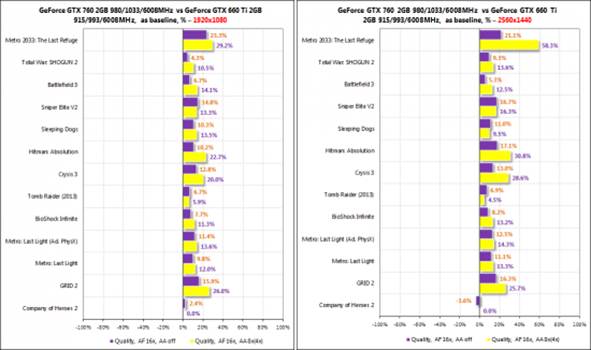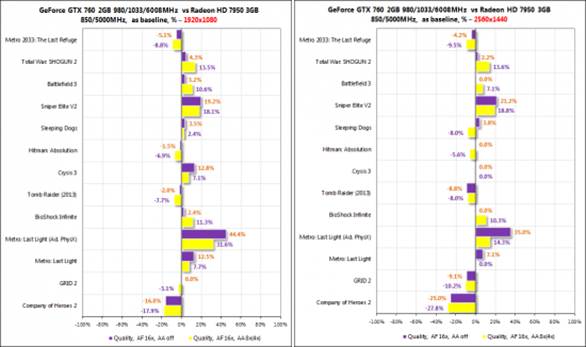Performance summary
First, let’s see how fast GeForce GTX 760 is when comparing to the old GeForce GTX 660 Ti at
their default clock rate:

GeForce
GTX 760 versus the old GeForce GTX 660 Ti at default clock rate
The new card may have bigger advantages in Metro
2033: The Last Refuge and at AA settings in other games. It can be expected
because it’s in the power-consuming mode which larger memory bus has the most
powerful effect to the performance. GeForce GTX 760 is 10-15% faster in average
than GeForce GTX 660 Ti at 1,920x1,080 and 11-18% faster at 2,560x1,440 in all
tests. That’s good, considering that its’ cheaper.
Now let’s check the distance between GeForce
GTX 760 and GeForce GTX 670.

The
distance between GeForce GTX 760 and GeForce GTX 670
The new card is not much slower than other
expensive products belonging to the new generations. The gap is only 7-8% at
both resolutions. The gap between GeForce GTX 770 and its premium relatives is
bigger:

The
new card is not much slower than other expensive product of the last generation
It’s 16-17% at 1,920x1,080 and about 18% at
2,560x1,440, for average. GeForce GTX 760 can be overclocked to shorten the
distance and it even win in one test:

GeForce
GTX 760 can be overclocked to minimize the distance
Now let’s compare GeForce GTX 760 and Radeon
HD 7950 at their default clock rate. We can remind you that the presentation of
Nvidia promises the advantages of 10-15% in a large number of games. But what
do we have in our own tests?

Comparing
GeForce GTX 760 and Radeon HD 7950 at default clock rate
In fact, GeForce GTX 760 seems to be
actually good when comparing with the more expensive part, but Radeon HD 7950 is
still ahead in games such as Metro 2033: The Last Refuge, Hitman:
Absolution, Tomb Raider (2013), GRID 2 and Company of
Heroes 2. GeForce GTX 760 wins in almost other games, becoming incredibly
impressive in Metro: Last Light and in the new Sniper Elite V2.
Here are the additional diagrams for you
reference:
·
GeForce GTX 670 vs. Radeon HD 7950 at default
frequency;
·
GeForce GTX 670 vs. Radeon HD 7950 while
overclocked;
·
Overclocked GeForce GTX 670 vs. nominal GeForce
GTX 770.
Conclusion
First of all, I’d like to notice the
readers that MSRP of Nvidia GeForce GTX 760 has the price of $249. And though
the fact that the market doesn’t let it stable at that price fast enough, this
new graphics accelerator can be an attractive purchase from many means. Though
it graphics processor is weaker in terms of technique, GeForce GTX 760 is
better than GeForce GTX 660 Ti thanks to its 256 bit memory, higher GPU
overclocking rate and GPU Boost 2.0 tech. as a result, GeForce GTX 760 proves
to have 14% advantages, in average, compared to GTX 660 Ti. Besides, currently
we can also see that the card lags behind a little bit (about 8%) compared to a
graphics card from a completely different category, but belonging to the last
generation - GeForce GTX 670, which can easily be crossed out by overclocking
the new GeForce GTX 760. However, our hero can’t catch up with the GTX 770 product
even in overclocked mode. Besides, the differences in recommended price between
the 2 proposals that it’s pretty logical when having something like a GeForce
GTX 760 Ti to fill in this gap. Besides, GeForce GTX 760 competes quite
successfully with a more expensive Radeon HD 7950, but one more time, this
conclusion bases on the recommended price. We will quickly find out that what
will it be when this graphics card is starting to be sold at stores. For the
weakness of GeForce GTX 760 reference, there’s only 1 thing that should be
pointed out at this moment: the cooling system is noisy and ineffective. So, if
you decide to buy one of this new graphics card for yourself, we highly recommend
that you should check the exclusive design with alternative coolers and
increase the clock rate.
|
Technical
specs of Nvidia GeForce GTX 760 2 GB
·
Graphics processor: GK104 "Kepler"
(TSMC)
·
Manufacturing process, nm: 28 (low-k)
·
Die size, mm2: 294
·
Transistor, MLN: 3540
·
GPU frequency, MHz: 980 (1033-boost) (3D); 135
(2D)
·
Unified shading processor: 1152
·
Structure-forming unit: 96
·
Raster operator (ROPs): 32
·
Theoretical max Fill rate: 31.4
·
Theoretical max structure rate, Gtexel/s: 94.1
·
Pixel Shader / Vertex Shader, version: 5.0/5.0
·
Supporting memory type: GDDR5
·
Video-effective memory frequency: 3D: 6008;
2D: 648
·
Memory size, MB: 2048
·
Memory bus width, bit: 256
·
Memory bus bandwidth, GB/s:192.3
·
Highest power consumption, W: 3D: 170, 2D: no
data
·
Computer power, W: 500
·
Reference PCB size: 242x100x36
·
Interface: PCI-Expressx16 (v3.0)
·
Output: DVI-I + DVI-D (Dual-link), 1 HDMI
v1.4a, 1 DisplayPort v1.2
·
MSRP/ lowest retail price, USD: $249
|